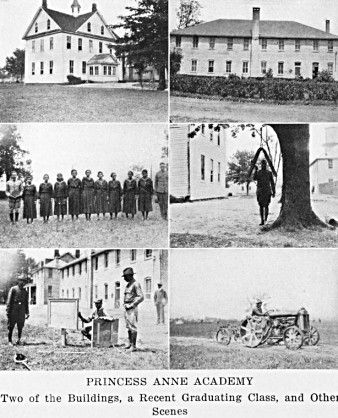
(pg. 91) by the Rev. Jay S. Stowell © 1922
During the 1913-14 academic year, the Ford Motor Co. pioneered use of an assembly line to build cars, President Woodrow Wilson authorized the creation of the Federal Reserve Bank, Charlie Chaplin made his film debut in “Making A Living” and the Phi Beta Sigma fraternity was founded at Howard University in Washington.
Not far from the nation’s capital, 125 students were enrolled in an impressive array of “academic and industrial” classes offered at Princess Anne Academy they hoped would help them get ahead in life.
At the time, the Academy provided instruction to young Blacks at two levels, which in the early 21st century would be equivalent to middle and high school work. The school was supported jointly by the state of Maryland and the Methodist church.
Tuition was free, but students were expected to pay a $1 entrance fee, a $2 book deposit, 50 cents for an athletics fee, and if they lived on campus, $9.75 a month for room and board. Uniforms for boys were $10; girls paid $5.
Students participated in routine “military exercises,” which apparently were akin to calisthenics. The handbook advised boarding students what personal items they should bring to Princess Anne, described as a bucolic location with a “climate … mild and healthful.”
The Academy that school year attracted local students from Somerset as well as neighboring counties on the Delmarva Peninsula and as far away as New Jersey, Pennsylvania and West Virginia.
Thomas H. Kiah was in his fourth year as principal of the school, which included a 117-acre working farm with crops and livestock.
Academic offerings included:
- Math: arithmetic, algebra, geometry and bookkeeping
- Physical science: geography, zoölogy, botany, physiology, chemistry, physics and agriculture
- Education: history and pedagogy
- History: English, European, Roman and American
- Language and literature: grammar, composition, reading, the Bible, and as an option, up to four years of Latin
- Art: drawing and vocal music
Industrial instruction included: blacksmithing and wheelwrighting; carpentry and cabinet-making; agriculture and animal husbandry; dairying, printing, sewing and cooking.
This information was gleaned from a copy of “The Morgan College Bulletin,” an official publication for the Baltimore school and its two branch campuses in Princess Anne and Lynchburg, Va. It is the oldest such “year book” / course catalog in the University of Maryland Eastern Shore’s archives housed at the Frederick Douglass Library. The inside cover page of the 1913-14 edition notes it was published in Princess Anne, presumably by the print shop where students learned the trade.

